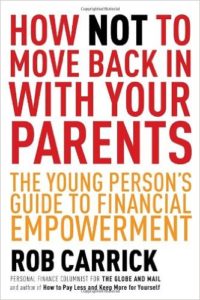 You’re a millennial. You’ve recently graduated from university and are beginning your career. You aren’t making quite as much as you’d hoped for, and as it turns out, rent is crushingly expensive.
You’re a millennial. You’ve recently graduated from university and are beginning your career. You aren’t making quite as much as you’d hoped for, and as it turns out, rent is crushingly expensive.
Okay, you’ll just put off moving out for six months, save some money, live at home. Everyone’s doing it these days. You’re sure that before you know it you’ll be on track to success, living it up in homeowner-ville, sitting pretty. You’re not quite sure exactly how you’ll get to homeowner-ville, but it can’t be that hard, right?
If any of this sounds plausible, I would seriously consider reading this wonderful book called How Not to Move Back in With Your Parents – The Young Person’s Guide to Financial Empowerment by Globe and Mail personal finance columnist Rob Carrick. I don’t want to be dramatic and say it will be your new finance bible, but it’s definitely a book you’re going to be referencing time and time again throughout those first few post-graduate years.
Something I really love about this book is that it’s broken down into great detail. Not only that, but it’s organized according to when in life you should be needing the advice.
Covering all the financial bases
HNTMBIWYP (as I will be referring to it henceforth) actually begins before college, with tips and important information on affording school and budgeting once you’re there. From there Carrick covers pretty much all the financial bases young people need to be aware of.
These include how to manage debt, how to shop around for banks and ‘play the field’ when it comes to your choice of financial institutions, how to create and stick to a budget that works, buying a car, buying a house, financing a wedding and starting a family, and how to protect yourself and your belongings with insurance and wills. Woo — that was a lot!
You’d think it would be easy to get overwhelmed while reading HNTMBIWYP (originally published by Doubleday Canada in 2012), but it’s so well laid out, and flows so well that the information within just makes sense. As I was reading, I came across countless useful tidbits that I had to highlight and make note of for future reference.
Emergency Funds & Building Savings
 One tidbit I’d like to share is the idea of an emergency fund. I recently participated in a video chat with Chantel Chapman of MOGO and Jonathan Chevreau (my dad) in which the idea of an emergency fund was discussed. Chantel, as with most other financial advice-givers, recommended a 3-month salary buffer for an emergency fund.
One tidbit I’d like to share is the idea of an emergency fund. I recently participated in a video chat with Chantel Chapman of MOGO and Jonathan Chevreau (my dad) in which the idea of an emergency fund was discussed. Chantel, as with most other financial advice-givers, recommended a 3-month salary buffer for an emergency fund.
Carrick suggests, however, that young people don’t worry about the amount right away. He says what’s important is that you just put a little in each month. “Start with a couple of hundred dollars in a high-interest savings account and try to build up to a few thousand dollars.” I like the idea of building up the fund over time, instead of worrying about it all at once.
Building savings over time is a theme that pops up throughout HNTMBIWYP, and is discussed again in reference to making contributions to RRSPs and TFSAs. Carrick recommends here that instead of making a contribution once a year, to have the money come out at steady intervals throughout the year so you feel the brunt of it less heavily. As an added bonus, says Carrick, doing it this way helps us to average out from highs and lows that the market might reach.
Though How Not to Move Back In With Your Parents is an effective tool for those of us with a background of financial knowledge, it is probably most helpful to complete newbies. Rob Carrick is with us, essentially holding our hand, telling us what we need to know and showing us what we need to do to get there. If it were up to me, HNTMBIWYP would be required reading for every person older than 17.
 Helen Chevreau is a student teacher, blogger and global adventurer. She also happens to be the daughter of Hub CFO Jonathan Chevreau. She has a B.A. in English and has been blogging for four years. Her next stop is Scotland for postgraduate studies in education.
Helen Chevreau is a student teacher, blogger and global adventurer. She also happens to be the daughter of Hub CFO Jonathan Chevreau. She has a B.A. in English and has been blogging for four years. Her next stop is Scotland for postgraduate studies in education.

